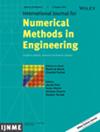Normalized Field Product Approach: A Parameter-Free Density Evaluation Method for Close-To-Binary Solutions in Topology Optimization With Embedded Length Scale
Abstract
This article provides a normalized field product approach for topology optimization to achieve close-to-binary optimal designs. The method uses a parameter-free density measure that enforces a specified minimum length scale on the solid phase, ensuring smooth and transition-free topologies. The density evaluation does not rely on weight functions; however, the associated density functions are required to confined between 0 and 1. The method combines the SIMP scheme with the introduced density function for material stiffness interpolation. The success and efficacy of the approach are demonstrated through the design of both two- and three-dimensional designs, including stiff structures and compliant mechanisms. The structure's compliance is minimized for the former, whereas the latter involves optimizing a multicriteria objective. The presented numerical examples consider different volume fractions, length scales, and density functions. The proposed method is also seamlessly extended with advanced elements for solving 3D problems. The optimized designs obtained are close to binary without any user intervention while satisfying the desired feature size on the solid phase.

 求助内容:
求助内容: 应助结果提醒方式:
应助结果提醒方式:


